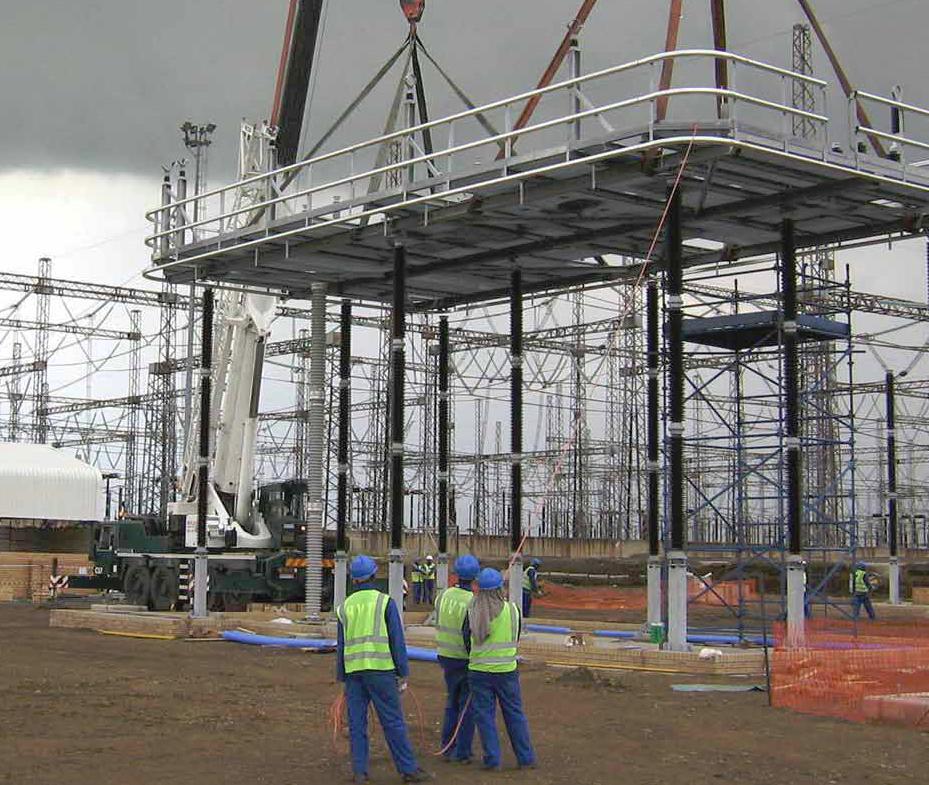
With Eskom’s New Build Programme forging ahead, Jeff Daniel talks to Johan Bornman, acting general manager for Power Delivery Projects (PDP), the Eskom department responsible for the building and refurbishment of transmission lines and substations in South Africa.
PDP was established in 2005 and is divided into four portfolios—three based on geographical coverage: Northern, Central and Cape, and the fourth responsible for the new 765kV integration. This includes the integration of the new power stations into the national grid. PDP builds lines and substations and refurbishes others; it also has the task of building the popular 765kV transmission network, which will benefit the transfer of power from Mpumalanga down to the Western Cape. The main focus is on 400kV and 765kV with also some 275kV lines. There is also major power stations integration, including the Medupi, Kusile and Ingula power stations.
This department is entrusted with a massive budget stretching to tens of billions of rand, all in different phases of development and execution. PDP is currently working on 22 projects and schemes in execution on 51 sites around the country. The department has a total 209 permanent staff, complemented by the contractors total personnel pool of approximately 4,300. The number of sites will increase to about 80 sites at the end of 2011; and personnel will also increase to between 7,000 and 8,000. PDP prides itself on its mottos: “Passionate about safety; deliver and celebrate success” and “Powerful team—aligned, cohesive and fearless”, ensuring that Eskom stays recognised as one of the top utilities worldwide. Since inception, this department has built 3,103 kilometres of lines and 15,670MVA as at the end of January 2011.
Power transmission is the movement of electricity from the point of generation to a substation from which it can be distributed to consumers. The focus is on SA grid code compliance and to ensure the country has an uninterrupted power supply to support mines and industry, rural development, government objectives for growing the economy, job creation and domestic customers. The ultimate objective is to ensure excellent customer service.
Acting general manager for PDP Johan Bornman explains: “Normally, long distance transmission networks operate at 275 or 400kV but the further you go, the greater the loss of power. By increasing the potential of the transmission line to 765kV, the network operates more efficiently. It’s an expensive exercise because everything needs to be built on a much larger scale and it’s the sort of solution only justified where particularly long distances are involved or where a huge quantity of energy needs to be transmitted. To the best of our knowledge, we are one of only seven countries in the world that utilises the 765kV platform extensively.”
Everything about a 765kV transmission line is bigger and more costly than at 400kV, but it’s a system that does offer real economies of scale. The towers stand higher and wider but can transmit more than three times the amount of energy.
“With 765kV,” says Bornman, “the three phases need to be held almost twice as wide as 400kV with regard to air insulation. Each phase has six 27mm diameter steel cored aluminium conductors in a hexagonal configuration, and it’s been calculated that the total amount of cabling strung over the last three years—just over 1,100 kilometres—would stretch halfway around the world. The balance of the 3,103 kilometres was done of 400kV and 275kV which makes up for stringing conductor around the other half of the world. Thus we have now gone around the world with all the conductor strung to date.”
On the 765kV, the balance of the 1,800 kilometres is due for completion by 2013. Along the route there are a series of strategically placed transmission substations where the load can be distributed to centres of activity where it’s needed.
The increase in activity in PDP has been truly staggering, doubling each year since the department was formed in 2005. However, just like in any project environment, PDP is faced with some challenges which include servitudes acquisition and environmental issues. These possible delays are mitigated through the application of different procurement strategies, ensuring the deployment of more contractors and resources allocation. If this is done, there can be a depletion in the number of contractors available for the remaining work. PDP has realised this risk and proactively started three years ago with a Lines, Civil and Electrical Construction Forum, where all vendors are informed about new project releases and enquiries that are forecasted. This ensures a sustainable platform is built where growth is triggered in the construction industry through active partnering. This kind of workload impacts throughout the chain of command, as there is a direct correlation between the amount being spent and the number of individuals needed to work on the project. Bornman and his team maintain a close partnership with these contractors. “With such a workload,” he says, “coupled with a general skills shortage, all those involved need to plan ahead to avoid skills shortages.”
In terms of the projects synopsis in this five year window ending 2013, the transformers capacity installed will reach 20,600 MVAs. In total, the transmission lines will total 4,000 kilometres.
It is also important to note Eskom itself does not construct the line but carries out detailed design and procurement and management functions. In order to save costs, Eskom procures all its conductor, hardware and insulators to be used by various contractors. “Our role is to design, procure and manage,” Bornman says. “In line with our contracting strategy, we put together a complete bill of quantities and construction package that specifies all the necessary details for the construction tender. The actual supply and construction of the transmission line and substation work is left to specialist contractors.”
With much of the work on the 765kV lines being carried out at heights of 50 metres, there is a greater risk of accidents and injuries. Therefore great emphasis is placed on working with contractors to ensure that they carry out the proper procedures and supervision of work so that incidents are avoided. “At some point our LTIR ratio (lost time incident rate) was unacceptably high. We have a target of 0.4 and at its worst the figure hit 0.74. However, through hard work and partnerships with our contractors, the efforts we have put in are bearing fruit as the current figure is down to 0.3. This is testimony that safety is a priority in all our projects.”
A number of innovative proactive measures were taken. PDP has formed a Contractor SHEQ Forum with the whole construction industry, where the industry is informed about the detailed requirements, latest developments and strategies being developed. This is done quarterly. PDP has actively formed working groups with the construction industry in developing strategies and solutions for issues like sub-contractor management, training due to language barriers, supervising skills, design for safety and risk assessments. In addition, through reviews and utilising panel interviews, PDP interacts with the worst performing contractors to establish solutions for a turnaround.
Apart from focusing on making sure that new transmission lines and substations are built, PDP, together with its contractors, always gives back to the communities. A number of corporate social investment projects have benefited communities and improved the lives of local people. PDP constantly partners with contractors to identify needs in rural communities, with initiatives executed through the contractors. Bornman concludes: “This is part of the legacy to South Africa that our teams are delivering. These projects are in the interest of the country and we have the duty to execute them in a professional and safe manner, building Eskom’s image and reputation.”
DOWNLOAD
 Eskom_APR_11_emea_bro-s.pdf
Eskom_APR_11_emea_bro-s.pdf












